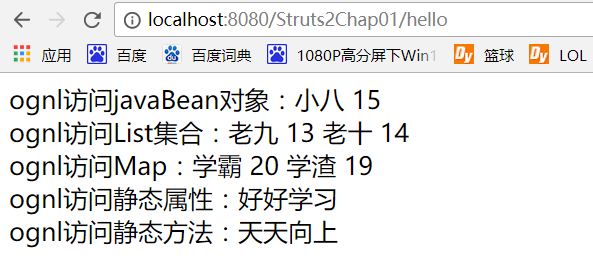struts2学习(7)值栈简介与OGNL引入
一、值栈简介:

二、OGNL引入:

com.cy.action.HelloAction.java:
package com.cy.action; import java.util.Map; import com.opensymphony.xwork2.ActionContext;
import com.opensymphony.xwork2.ActionSupport;
import com.opensymphony.xwork2.util.ValueStack; public class HelloAction extends ActionSupport{
private static final long serialVersionUID = 1L; @Override
public String execute() throws Exception {
ActionContext actionContext = ActionContext.getContext();
ValueStack valueStack = actionContext.getValueStack();
valueStack.set("name", "张三(valueStack)");
valueStack.set("age", 11); Map<String, Object> session = actionContext.getSession();
session.put("name", "王五(session)");
session.put("age", 13); Map<String, Object> application = actionContext.getApplication();
application.put("name", "赵六(application)");
application.put("age", 14); return SUCCESS;
} }
struts.xml:
<struts>
<package name="manage" namespace="/" extends="struts-default">
<action name="hello" class="com.cy.action.HelloAction">
<result name="success">success.jsp</result>
</action>
</package>
</struts>
success.jsp:
<%@ page language="java" contentType="text/html; charset=UTF-8" pageEncoding="UTF-8"%>
<%@taglib prefix="s" uri="/struts-tags" %>
<!DOCTYPE html PUBLIC "-//W3C//DTD HTML 4.01 Transitional//EN" "http://www.w3.org/TR/html4/loose.dtd">
<html>
<head>
<meta http-equiv="Content-Type" content="text/html; charset=UTF-8">
<title>Insert title here</title>
<%
request.setAttribute("name", "李四(request)");
request.setAttribute("age", 12); pageContext.setAttribute("name", "小沛(page)");
pageContext.setAttribute("age", "18");
%>
</head>
<body>
获取狭义上的值栈数据:<s:property value="name"/>
<s:property value="age"/><br>
请求参数:<s:property value="#parameters.name"/>
<s:property value="#parameters.age"/><br>
request:<s:property value="#request.name"/>
<s:property value="#request.age"/><br>
session:<s:property value="#session.name"/>
<s:property value="#session.age"/><br>
application:<s:property value="#application.name"/>
<s:property value="#application.age"/><br>
attr取值:<s:property value="#attr.name"/>
<s:property value="#attr.age"/><br>
</body>
</html>
测试结果:

三、OGNL访问复杂对象:

四、OGNL访问静态属性和静态方法:

com.cy.model.Student.java:
package com.cy.model;
public class Student {
private String name;
private int age;
public Student() {
super();
// TODO Auto-generated constructor stub
}
public Student(String name, int age) {
super();
this.name = name;
this.age = age;
}
public String getName() {
return name;
}
public void setName(String name) {
this.name = name;
}
public int getAge() {
return age;
}
public void setAge(int age) {
this.age = age;
}
}
com.cy.common.MyStatic.java:静态属性和静态方法:
package com.cy.common;
public class MyStatic {
public static final String str = "好好学习";
public static String print(){
return "天天向上";
}
}
com.cy.action.HelloAction.java中存入javaBean、List、Map:
package com.cy.action; import java.util.ArrayList;
import java.util.HashMap;
import java.util.List;
import java.util.Map; import com.cy.model.Student;
import com.opensymphony.xwork2.ActionContext;
import com.opensymphony.xwork2.ActionSupport;
import com.opensymphony.xwork2.util.ValueStack; public class HelloAction extends ActionSupport{
private static final long serialVersionUID = 1L; private Student student;
private List<Student> students;
private Map<String,Student> studentMap; public Map<String, Student> getStudentMap() {
return studentMap;
} public void setStudentMap(Map<String, Student> studentMap) {
this.studentMap = studentMap;
} public List<Student> getStudents() {
return students;
} public void setStudents(List<Student> students) {
this.students = students;
} public Student getStudent() {
return student;
} public void setStudent(Student student) {
this.student = student;
} @Override
public String execute() throws Exception {
ActionContext actionContext = ActionContext.getContext();
ValueStack valueStack = actionContext.getValueStack();
valueStack.set("name", "张三(valueStack)");
valueStack.set("age", 11); Map<String, Object> session = actionContext.getSession();
session.put("name", "王五(session)");
session.put("age", 13); Map<String, Object> application = actionContext.getApplication();
application.put("name", "赵六(application)");
application.put("age", 14); student = new Student("小八", 15); students=new ArrayList<Student>();
students.add(new Student("老九",13));
students.add(new Student("老十",14)); studentMap=new HashMap<String,Student>();
studentMap.put("goodStudent", new Student("学霸",20));
studentMap.put("badStudent", new Student("学渣",19)); return SUCCESS;
} }
struts.xml配置,开启ognl允许访问静态方法:
<struts>
<!-- 允许OGNL访问静态方法 -->
<constant name="struts.ognl.allowStaticMethodAccess" value="true"></constant> <package name="manage" namespace="/" extends="struts-default">
<action name="hello" class="com.cy.action.HelloAction">
<result name="success">success.jsp</result>
</action> </package> </struts>
success.jsp,通过ognl来取值:
<%@ page language="java" contentType="text/html; charset=UTF-8" pageEncoding="UTF-8"%>
<%@taglib prefix="s" uri="/struts-tags" %>
<!DOCTYPE html PUBLIC "-//W3C//DTD HTML 4.01 Transitional//EN" "http://www.w3.org/TR/html4/loose.dtd">
<html>
<head>
<meta http-equiv="Content-Type" content="text/html; charset=UTF-8">
<title>Insert title here</title>
</head>
<body>
ognl访问javaBean对象:<s:property value="student.name"/>
<s:property value="student.age"/><br>
ognl访问List集合:<s:property value="students[0].name"/>
<s:property value="students[0].age"/>
<s:property value="students[1].name"/>
<s:property value="students[1].age"/><br/>
ognl访问Map:<s:property value="studentMap['goodStudent'].name"/>
<s:property value="studentMap['goodStudent'].age"/>
<s:property value="studentMap['badStudent'].name"/>
<s:property value="studentMap['badStudent'].age"/><br/> ognl访问静态属性:<s:property value="@com.cy.common.MyStatic@str"/><br>
<!-- 访问静态方法,有些封装好的Util工具,转换等,就可以直接调用了 -->
ognl访问静态方法:<s:property value="@com.cy.common.MyStatic@print()"/>
</body>
</html>
测试:

---------
struts2学习(7)值栈简介与OGNL引入的更多相关文章
- Struts2学习:值栈(value stack)
1.index.jsp <%@ page contentType="text/html;charset=UTF-8" language="java" %& ...
- Struts2基础学习(七)—值栈和OGNL
目录: 一.值栈 二.OGNL表达式 一.值栈(ValueStack) 1.定义 ValueStack贯穿整个Acton的生命周期,每个Action类的对象实例都拥有一个ValueStack ...
- 关于Struts2中的值栈与OGNL表达式
1.1.1 OGNL概述: Object Graphic Navigation Language(对象图导航语言)的缩写 * EL :OGNL比EL功能强大很多倍. 它是一个开源项目. ...
- 学习Struts--Chap05:值栈和OGNL
1.值栈的介绍 1.1 值栈的介绍: 值栈是对应每一个请求对象的数据存储中心,struts2会给每一个请求对象创建一个值栈,我们大多数情况下不需要考虑值栈在哪里,里面有什么,只需要去获取自己需要的数据 ...
- struts2中各种值栈问题
struts2中OGNL和 ValueStack(一) 收藏 学习的时候,总分不清楚在struts2中页面的传值和取值是怎么来完成的,所以从网上搜了很多资料,现在把这些资料总结写,留着以后参考..看完 ...
- Struts2 中的值栈的理解
通过对struts2的一段时间的接触,将自己对OGNL的核心值栈说说,值栈:简单的说,就是存放action的堆栈,当我们提交一个请求 道服务器端 action时,就有个堆栈,如果action在服务器端 ...
- Struts学习之值栈的理解
转自:http://blog.csdn.net/hanxuemin12345/article/details/38559979 页面一个请求发送过来,依次经过一系列拦截器(处理公共部分,如:往数据中心 ...
- struts2中的值栈对象ValueStack
ValueStack, 即值栈对象. 值栈对象: 是整个struts数据存储的核心,或者叫中转站. 用户每次访问struts的action,都会创建一个Action对象.值栈对象.ActionCont ...
- Struts2中的值栈
一 什么是值栈 值栈: struts2中提供的一种类似于域对象的工具, 用于struts2中的存值和取值. 每次访问Action的时候, 都会创建一个action对象, 而每个action对象中都存在 ...
随机推荐
- Rsync安装和配置
一.Rsync简介 1.1什么是Rsync Rsync是一款快速的,开源的,多功能的,可以实现全量和增量的远程和本地的数据同步和数据备份的工具. 全量的概念是:全部备份. 增量的概念是:差异化备份.对 ...
- jQuery动画与特效
参考:jQuery权威指南jQuery初步jQuery选择器jQuery操作domjQuery操作dom事件jQuery插件jQuery操作AjaxjQuery动画与特效jQuery实现导航栏jQue ...
- Java基础学习-常见API
package commonAPIs; /*java.lang 类 Object java.lang.Object public class Object类 Object 是类层次结构的根类.每个类都 ...
- Linux:更改hostname主机名
更改hostname主机名 查看主机名 hostname 临时更改主机名 hostname youname 更改永久生效主机名 1)更改配置文件 vi /etc/sysconfig/network 2 ...
- Linux:centOS LAMP搭建之软件包下载地址
MySQL5.1 wget mysql-5.1.73-linux-i686-glibc23.tar.gz #二进制包 MySQL5.6 wget http://mirrors.sohu.com/mys ...
- python kd树 搜索 代码
kd树就是一种对k维空间中的实例点进行存储以便对其进行快速检索的树形数据结构,可以运用在k近邻法中,实现快速k近邻搜索.构造kd树相当于不断地用垂直于坐标轴的超平面将k维空间切分,依次选择坐标轴对空间 ...
- python爬虫入门(4)-补充知识:XPath 教程(转自w3school)
http://www.w3school.com.cn/xpath/index.asp 参考手册:http://www.w3school.com.cn/xpath/xpath_functions.asp ...
- 【剑指offer】栈的压入弹出序列,C++实现(举例)
原创文章,转载请注明出处! 本题牛客网地址 博客文章索引地址 博客文章中代码的github地址 1.题目 输入两个整数序列,第一个序列表示栈的压入顺序,请判断第二个序列是否为第一个序列的出栈序列.注意 ...
- Web应用中使用JavaMail发送邮件进行用户注册
现在很多的网站都提供有用户注册功能, 通常我们注册成功之后就会收到一封来自注册网站的邮件.邮件里面的内容可能包含了我们的注册的用户名和密码以及一个激活账户的超链接等信息.今天我们也来实现一个这样的功能 ...
- Object-C 中的Selector 概念
selector可以叫做选择器,其实指的就是对象的方法,也可以理解为C语言里面的函数指针,在面向对象里面的对应概念. @selector(xxxx)的作用是找到名字为xxxx的方法.一般用于[a pe ...
